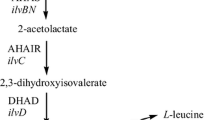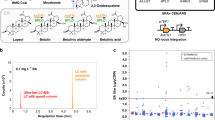Abstract
Candida glabrata is one of the most promising pyruvate producers. A series of experiments was conducted to enhance pyruvate production by C. glabrata via metabolic and genetic engineering. Here, a novel screening strategy, which combined atmospheric and room temperature plasma-based random mutagenesis and high-throughput screening (HTS), was used to screen for high pyruvate-producing mutants that could use cheap industrial raw materials as nitrogen sources. A high-titer pyruvate producer (H6) was obtained form 30,000 mutants after 30 rounds of mutagenesis and HTS. Compared with a wild-type strain, pyruvate production by the H6 mutant was 32.2 and 35.4% higher in 500-mL shake flasks and 3-L fermenter, respectively, when cheap peptone was used as the nitrogen source in the seed culture stage. The HTS process significantly improved the screening efficiency and reduced fermentation cost. This procedure could also easily be applied to screen for strains that produce high titers of similar organic acids.






Similar content being viewed by others
References
Xu P, Qiu JH, Gao C, Ma CQ (2008) Biotechnological routes to pyruvate production. J Biosci Bioeng 105(3):169–175. doi:10.1263/jbb.105.169
Qin Y, Johnson CH, Liu L, Chen J (2011) Introduction of heterogeneous NADH reoxidation pathways into Torulopsis glabrata significantly increases pyruvate production efficiency. Korean J. Chem Eng 28(4):1078–1084. doi:10.1007/s11814-010-0483-1
Wang QH, He P, Lu DJ, Shen A, Jiang N (2005) Metabolic engineering of Torulopsis glabrata for improved pyruvate production. Enzyme Microb Tech 36(5–6):832–839. doi:10.1016/j.enzmictec.2005.01.015
Qin Y, Dong Z, Zhou J, Liu L, Chen J (2009) Significantly increase of glycolytic flux and pyruvate productivity in Torulopsis glabrata by heterologous expression of NADH alternative oxidase. Wei sheng wu xue bao = Acta Microbiol Sin 49 (11):1483–1488
Yovkova V, Otto C, Aurich A, Mauersberger S, Barth G (2014) Engineering the alpha-ketoglutarate overproduction from raw glycerol by overexpression of the genes encoding NADP+-dependent isocitrate dehydrogenase and pyruvate carboxylase in Yarrowia lipolytica. Appl Microbiol Biot 98(5):2003–2013. doi:10.1007/s00253-013-5369-9
Zhang X, Zhang C, Zhou QQ, Zhang XF, Wang LY, Chang HB, Li HP, Oda Y, Xing XH (2015) Quantitative evaluation of DNA damage and mutation rate by atmospheric and room-temperature plasma (ARTP) and conventional mutagenesis. Appl Microbiol Biot 99(13):5639–5646. doi:10.1007/s00253-015-6678-y
Lu Y, Wang L, Ma K, Li G, Zhang C, Zhao H, Lai Q, Li H-P, Xing X-H (2011) Characteristics of hydrogen production of an Enterobacter aerogenes mutant generated by a new atmospheric and room temperature plasma (ARTP). Biochem Eng J 55 (1):17–22. doi:10.1016/j.bej.2011.02.020
Zhang X, Zhang XF, Li HP, Wang LY, Zhang C, Xing XH, Bao CY (2014) Atmospheric and room temperature plasma (ARTP) as a new powerful mutagenesis tool. Appl Microbiol Biot 98(12):5387–5396. doi:10.1007/s00253-014-5755-y
Duetz WA, Ruedi L, Hermann R, O’Connor K, Buchs J, Witholt B (2000) Methods for intense aeration, growth, storage, and replication of bacterial strains in microtiter plates. Appl Environ Microb 66(6):2641–2646. doi:10.1128/aem.66.6.2641-2646.2000
Tan J, Chu J, Hao Y, Guo Y, Zhuang Y, Zhang S (2013) High-throughput system for screening of Cephalosporin C high-yield strain by 48-deep-well microtiter plates. Appl Biochem Biotech 169(5):1683–1695. doi:10.1007/s12010-013-0095-4
Shi F, Tan J, Chu J, Wang YH, Zhuang YP, Zhang SL (2015) A qualitative and quantitative high-throughput assay for screening of gluconate high-yield strains by Aspergillus niger. J Microbiol Methods 109:134–139. doi:10.1016/j.mimet.2014.12.004
Liu LM, Li Y, Li HZ, Chen J (2004) Manipulating the pyruvate dehydrogenase bypass of a multi-vitamin auxotrophic yeast Torulopsis glabrata enhanced pyruvate production. Lett Appl Microbiol 39(2):199–206. doi:10.1111/j.1472-765X.2004.01563.x
Zhou J, Huang L, Liu L, Chen J (2009) Enhancement of pyruvate productivity by inducible expression of a F0F1-ATPase inhibitor INH1 in Torulopsis glabrata CCTCC M202019. J Biotechnol 144(2):120–126. doi:10.1016/j.jbiotec.2009.09.005
Chen J, Liu L-M, Li H-Z, Du G-C, Li Y (2005) Enhancement of pyruvate production by Torulopsis glabrata through supplement of oxaloacetate as carbon source. Biotechnol Bioproc E 10(2):136–141
Zeng W, Du G, Chen J, Li J, Zhou J A high-throughput screening procedure for enhancing α-ketoglutaric acid production in Yarrowia lipolytica by random mutagenesis. Process Biochem. doi:10.1016/j.procbio.2015.06.011
Li Y, Chen J, Lun SY, Rui XS (2001) Efficient pyruvate production by a multi-vitamin auxotroph of Torulopsis glabrata: key role and optimization of vitamin levels. Appl Microbiol Biot 55(6):680–685
Liu B, Sun Z, Ma XN, Yang B, Jiang Y, Wei D, Chen F (2015) Mutation breeding of extracellular polysaccharide-producing Microalga Crypthecodinium cohnii by a novel mutagenesis with atmospheric and room temperature plasma. Int J Mol Sci 16(4):8201–8212. doi:10.3390/ijms16048201
Hu X, Lin B, Yang S (2010) Comparison between several chemical detection methods of pyruvate production in fermentation. Cereals Oils Process 12(9):165–168
Binder S, Schendzielorz G, Staebler N, Krumbach K, Hoffmann K, Bott M, Eggeling L (2012) A high-throughput approach to identify genomic variants of bacterial metabolite producers at the single-cell level. Genome Biol 13(5). doi:10.1186/gb-2012-13-5-r40
Liu YN, Li QG, Zheng P, Zhang ZD, Liu YF, Sun CM, Cao GQ, Zhou WJ, Wang XW, Zhang DW, Zhang TC, Sun JB, Ma YH (2015) Developing a high-throughput screening method for threonine overproduction based on an artificial promoter. Microb Cell Fact 14:11. doi:10.1186/s12934-015-0311-8
Barkawi LS, Tam YY, Tillman JA, Pederson B, Calio J, Al-Amier H, Emerick M, Normanly J, Cohen JD (2008) A high-throughput method for the quantitative analysis of indole-3-acetic acid and other auxins from plant tissue. Anal Biochem 372(2):177–188. doi:10.1016/j.ab.2007.08.009
Sun L, Zhang H, Yuan H, Tu R, Wang Q, Ma Y (2013) A double-enzyme-coupled assay for high-throughput screening of succinic acid-producing strains. J Appl Microbiol 114(6):1696–1701. doi:10.1111/jam.12175
Hoover SW, Tyler Youngquist J, Angart PA, Withers ST, Lennen RM, Pfleger BF (2012) Isolation of improved free fatty acid overproducing strains of Escherichia coli via nile red based high-throughput screening. Environ Prog Sustain 31(1):17–23. doi:10.1002/ep.10599
Mayr LM, Bojanic D (2009) Novel trends in high-throughput screening. Curr Opin Pharmacol 9(5):580–588. doi:10.1016/j.coph.2009.08.004
Liu LM, Xu QL, Li Y, Shi ZP, Zhu Y, Du GC, Chen J (2007) Enhancement of pyruvate osmotic-tolerant mutant production by of Torulopsis glabrata. Biotechnol Bioeng 97(4):825–832. doi:10.1002/bit.21290
Liu L-M, Chen J, Li H-Z, Li Y (2004) The decrease of the activity of electron transfer chain of Torulopsis glabrata enhanced pyruvate productivity. Wei sheng wu xue bao = Acta Microbiol Sin 44(6):800–804
Leduc M, Guay D, Coulombe S, Leask RL (2010) Effects of non-thermal plasmas on DNA and mammalian cells. Plasma Process Polym 7(11):899–909. doi:10.1002/ppap.201000032
Jia N, Ding MZ, Du J, Pan CH, Tian G, Lang JD, Fang JH, Gao F, Yuan YJ (2016) Insights into mutualism mechanism and versatile metabolism of Ketogulonicigenium vulgare Hbe602 based on comparative genomics and metabolomics studies. SCI, REP-UK 68. doi:10.1038/srep23068
Lelandais G, Tanty V, Geneix C, Etchebest C, Jacq C, Devaux F (2008) Genome adaptation to chemical stress: clues from comparative transcriptomics in Saccharomyces cerevisiae and Candida glabrata. Genome Biol 9(11):40. doi:10.1186/gb-2008-9-11-r164
Rossouw D, Naes T, Bauer FF (2008) Linking gene regulation and the exo-metabolome: A comparative transcriptomics approach to identify genes that impact on the production of volatile aroma compounds in yeast. Bmc. Genomics 9:18. doi:10.1186/1471-2164-9-530
Acknowledgements
This work was supported by the National High Technology Research and Development Program of China (863 Program, 2015AA021003, 2015AA021005), the National Natural Science Foundation of China (21276109), the Author of National Excellent Doctoral Dissertation of PR China (FANEDD, 201256) and the 111 Project (111-2-06).
Author information
Authors and Affiliations
Corresponding authors
Rights and permissions
About this article
Cite this article
Luo, Z., Zeng, W., Du, G. et al. A high-throughput screening procedure for enhancing pyruvate production in Candida glabrata by random mutagenesis. Bioprocess Biosyst Eng 40, 693–701 (2017). https://doi.org/10.1007/s00449-017-1734-x
Received:
Accepted:
Published:
Issue Date:
DOI: https://doi.org/10.1007/s00449-017-1734-x




